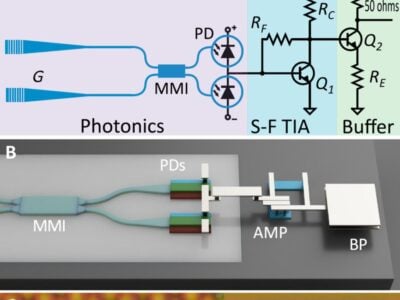
Spray-on antennas promise new smart tech, IoT applications
The breakthrough, say the researchers, could make installing an antenna for next-generation flexible electronics “as easy as applying some bug spray.” The key is the use of a new family of atomically thin 2D metal inorganic compounds – called “MXenes” – that have unique properties compared to conventional three-dimensional materials.
Graphene – which comprises just a single layer of carbon – is probably the most well-known 2D material, however it is limited to carbon in its composition. The new family of materials includes 2D early transition metal carbides, nitride, and carbonitrides. An MXene titanium carbide material was used in the Drexel research.
“This is a very exciting finding because there is a lot of potential for this type of technology,” says Kapil Dandekar, PhD, a professor of Electrical and Computer Engineering in the College of Engineering, who directs the Drexel Wireless Systems Lab, and was a co-author of the research. “The ability to spray an antenna on a flexible substrate or make it optically transparent means that we could have a lot of new places to set up networks — there are new applications and new ways of collecting data that we can’t even imagine at the moment.”
The MXene titanium carbide used by the researchers can be dissolved in water to create an ink or paint. Its exceptional conductivity, say the researchers, enables it to transmit and direct radio waves, even when it’s applied in a very thin coating.
“We found that even transparent antennas with thicknesses of tens of nanometers were able to communicate efficiently,” says Asia Sarycheva, a doctoral candidate in the A.J. Drexel Nanomaterials Institute and Materials Science and Engineering Department. “By increasing the thickness up to eight microns, the performance of MXene antenna achieved 98 percent of its predicted maximum value.”
Such ultra-thin antennas, say the researchers, would be able to be easily embedded – literally, sprayed on – in a wide variety of objects and surfaces without adding additional weight or circuitry or requiring a certain level of rigidity.
“This technology could enable the truly seamless integration of antennas with everyday objects which will be critical for the emerging Internet of Things,” Dandekar says. “Researchers have done a lot of work with non-traditional materials trying to figure out where manufacturing technology meets system needs, but this technology could make it a lot easier to answer some of the difficult questions we’ve been working on for years.”
Initial testing suggests that the spray-on antennas can perform with the same range of quality as current antennas made from conventional metals, but which are much thicker than MXene antennas.
“Current fabrication methods of metals cannot make antennas thin enough and applicable to any surface, in spite of decades of research and development to improve the performance of metal antennas,” says Yury Gogotsi, PhD, Distinguished University and Bach professor of Materials Science and Engineering in the College of Engineering, and Director of the A.J. Drexel Nanomaterials Institute, who initiated and led the project. “Therefore, we selected MXene, which is a two-dimensional titanium carbide material, that is stronger than metals and is metallically conductive, as a candidate for ultra-thin antennas.”
When compared against a variety of antennas made from other 2D materials – including graphene, silver ink, and carbon nanotubes – the MXene antennas were 50 times better than graphene and 300 times better than silver ink antennas in terms of preserving the quality of radio wave transmission, say the researchers.
“The MXene antenna not only outperformed the macro and micro world of metal antennas,” says Babak Anasori, PhD, a research assistant professor in A.J. Drexel Nanomaterials Institute, “we went beyond the performance of available nanomaterial antennas, while keeping the antenna thickness very low. The thinnest antenna was as thin as 62 nanometers – about thousand times thinner than a sheep of paper – and it was almost transparent. Unlike other nanomaterials fabrication methods … we made antennas in a single step by airbrush spraying our water-based MXene ink.”
The spray-on antenna was initially tested on both a rough substrate (cellulose paper) and on a smooth one (polyethylene terephthalate sheets). Looking ahead, the researchers say they will be looking at the best ways to apply it to a wide variety of surfaces from glass to yarn and skin.
“Further research on using materials from the MXene family in wireless communication,” says Anasori, “may enable fully transparent electronics and greatly improved wearable devices that will support the active lifestyles we are living.”
For more, see “2D titanium carbide (MXene) for wireless communication.”
Related articles:
New antenna design promises tinier wireless devices
Liquid antennas for IoT, 5G to be developed
Nanomaterial offers next-gen EMC shielding for flexible, wearable electronics
 If you enjoyed this article, you will like the following ones: don't miss them by subscribing to :
eeNews on Google News
If you enjoyed this article, you will like the following ones: don't miss them by subscribing to :
eeNews on Google News




